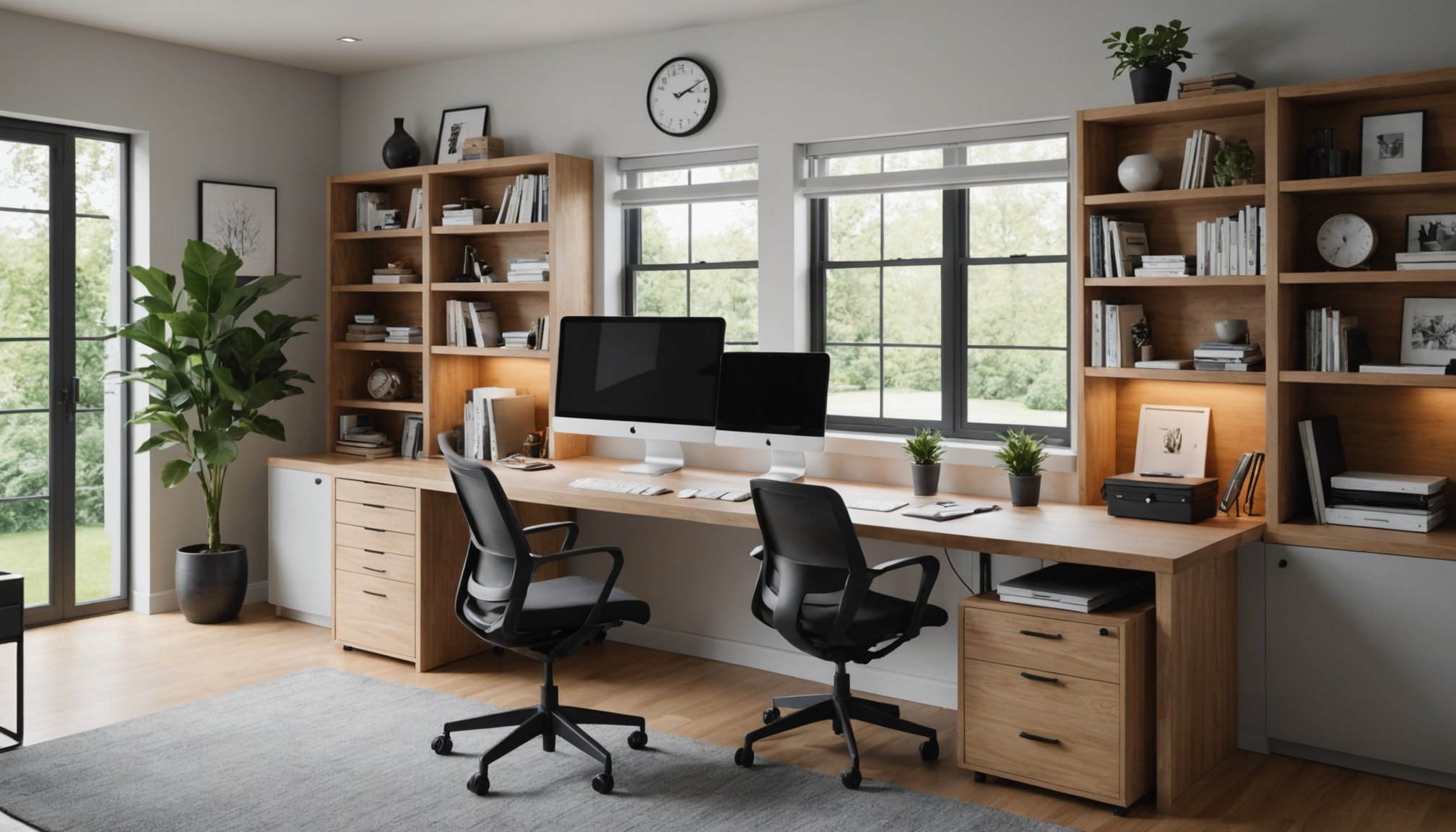Understanding Ergonomics
Ergonomics involves designing a workspace to fit the user’s needs, enhancing comfort and efficiency. In a home office setting, ensuring a proper ergonomic layout is crucial for both health and productivity. Essential ergonomic principles like proper posture, adjusting furniture to individual needs, and maintaining easy access to frequently used items are foundational in workspace design.
When applying these principles, consider the comfort and support offered by chairs and desks. It’s important to ensure that monitors are at eye level, and arms are comfortably bent at about a right angle while using the keyboard. Utilizing an ergonomic approach can significantly improve work comfort and efficiency, reducing strain injuries and increasing job satisfaction.
Also read : Flawless Makeup Mastery: The Comprehensive Guide to Protecting Your Skin from Extreme Weather Conditions
An ergonomic workspace offers numerous benefits, such as decreasing physical stress and maximizing productivity. By fostering a healthier work environment, individuals are more likely to maintain energy levels and focus throughout the day. Moreover, the reduction of physical discomfort directly contributes to fewer work-related healthcare issues over time. Consequently, investing in an ergonomic home office setup is a proactive measure for long-term wellness and performance enhancement.
Selecting Ergonomic Furniture
Selecting the right ergonomic furniture is crucial for creating a comfortable and efficient home office. Prioritizing high-quality chairs and desks can enhance your productivity and overall well-being.
Additional reading : Achieving Ageless Radiance: Expert Tips on Safely Adding Retinoids to Your Anti-Aging Skincare Routine
Ergonomic Chairs
When selecting an ergonomic chair, key features to look for include adjustability and support. A well-designed chair should have adjustable seat height, lumbar support, and armrests to cater to individual needs. This adjustability not only improves comfort but also maintains proper posture, reducing the risk of strain injuries. Several top-reviewed ergonomic chairs come recommended by experts for effectively preventing discomfort and promoting long-term health.
Ergonomic Desks
Choosing between standing and sitting desks can significantly impact your work comfort. While standing desks are praised for encouraging movement and reducing sedentary behaviour, sitting desks offer comfort for extended periods. Essential features include height adjustability and sufficient workspace. Popular ergonomic desk models are noted for their durability and user-friendly design. Both types of desks should support a healthy body posture to ensure sustained productivity and reduce fatigue.
These thoughtful considerations in selecting ergonomic furniture can vastly improve your home office experience, promoting both health and efficiency.
Optimizing Workspace Layout
Crafting an effective workspace layout is key to boosting productivity. Thoughtful space utilization can transform your home office into a hub of creativity and efficiency. The layout of your workspace should foster easy access to essential items and ensure that you can move comfortably.
Strategically place your desk to maximize natural light while avoiding glare on your computer screen. Ensure that frequently used items are within arm’s reach to reduce unnecessary movements. This arrangement is crucial in promoting seamless workflow and minimizing distractions.
Organization plays a vital role in maintaining a clean and productive environment. Cable management can prevent entanglement and clutter, fostering an orderly appearance. Use cable ties or covers to streamline your workstation. Furthermore, incorporating storage solutions like shelves or drawers helps keep your desk tidy, providing a clear space for focused work.
By optimizing your workspace layout, you not only enhance productivity but also elevate your work experience. A well-organized setting encourages focus and can significantly reduce the physical and mental strain often associated with cluttered spaces. Invest in this aspect to experience a noticeable uptick in your daily work routine.
Incorporating Wellness Features
Enhancing a home office with wellness features can significantly boost comfort and productivity. Incorporate elements that promote a healthier and more inviting workspace.
Lighting Solutions
Optimal lighting is vital for reducing eye strain and enhancing focus. Natural light is preferred, harnessing its comfort and energy-boosting properties. Strategically position your desk near windows to maximise daylight without glare on screens. Use sheer curtains to diffuse intense sunlight if needed. For artificial lighting, opt for adjustable lamps with LED bulbs that mimic daylight. Ensure your workspace is evenly lit to avoid shadows and eye fatigue.
Benefits of Plants in Office Space
Adding plants to your office brings psychological benefits, including stress reduction and increased creativity. Plants like spider plants, snake plants, and pothos are ideal for improving air quality and thriving in indoor conditions. They require minimal maintenance, needing just moderate light and regular watering. Choose plants that suit your light conditions for best results.
Incorporating wellness features like proper lighting and plants fosters an environment conducive to productivity and mental wellbeing in a home office. By thoughtfully integrating these elements, you enhance focus and create a more pleasant and efficient workspace.
Enhancing Focus and Reducing Fatigue
Creating a highly productive home office requires effective strategies to enhance focus and reduce fatigue. Start by setting up a dedicated workspace free from distractions. This means choosing a quiet area where interruptions are minimal. Consider using noise-cancelling headphones or white noise machines to maintain an environment conducive to concentration.
Regular breaks are vital for maintaining long-term focus and preventing fatigue. Experts recommend the Pomodoro Technique, where you work for 25 minutes and then take a 5-minute break. Such structured breaks help refresh the mind and maintain energy levels throughout the day. Incorporating short physical activities during breaks can further enhance focus and reduce stress. Simple exercises like stretching or taking a quick walk can rejuvenate both mind and body.
To support concentration, leverage technology tools. Numerous productivity apps are designed to block distracting websites, track time, and remind users to take breaks. These tools ensure you stay on task and efficiently manage work periods. Embracing these strategies and tools not only boosts productivity but also fosters a healthier, more dynamic home office environment.
Expert Opinions and Studies
In recent years, ergonomic studies have illuminated the substantial health benefits of well-designed workspaces. Research indicates that tailored ergonomic principles in a home office can significantly reduce musculoskeletal complaints. Experts advocate for customization in home office design, asserting that personalized adjustments not only enhance comfort but also boost productivity. A report by the National Institute for Occupational Safety and Health underscores that ergonomic furniture aligns with various body types, fostering healthier postures and reducing strain-related injuries.
Expert Insights
Expert insights suggest that investing in quality ergonomic elements like adjustable chairs and height-adaptable desks can lead to better posture and muscle relief. Renowned ergonomist Susan Hallbeck emphasises the critical role of chair adjustability in preventing lower back pain. Similarly, health professionals highlight the importance of having monitors positioned at eye level to avoid neck strain.
Case Studies
Case studies further affirm these findings, showcasing companies that implemented ergonomic setups and observed marked improvements in employee productivity and well-being. A notable study at a tech firm revealed that ergonomic changes led to a 20% uptick in efficiency. These examples mirror a growing consensus within expert communities: thoughtful ergonomic design translates directly into long-term health benefits and improved work performance.










